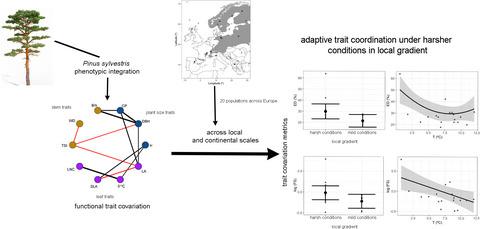Our official English website, www.x-mol.net, welcomes your
feedback! (Note: you will need to create a separate account there.)
Phenotypes of Pinus sylvestris are more coordinated under local harsher conditions across Europe
Journal of Ecology ( IF 5.3 ) Pub Date : 2021-04-21 , DOI: 10.1111/1365-2745.13668 Raquel Benavides 1, 2 , Bárbara Carvalho 1 , Silvia Matesanz 3 , Cristina C. Bastias 1, 4 , Stephen Cavers 5 , Adrián Escudero 3 , Patrick Fonti 6 , Elisabet Martínez‐Sancho 6 , Fernando Valladares 2, 3
中文翻译:

在整个欧洲当地更恶劣的条件下,樟子松的表型更加协调
更新日期:2021-04-21
Journal of Ecology ( IF 5.3 ) Pub Date : 2021-04-21 , DOI: 10.1111/1365-2745.13668 Raquel Benavides 1, 2 , Bárbara Carvalho 1 , Silvia Matesanz 3 , Cristina C. Bastias 1, 4 , Stephen Cavers 5 , Adrián Escudero 3 , Patrick Fonti 6 , Elisabet Martínez‐Sancho 6 , Fernando Valladares 2, 3
Affiliation

|
- Plant species that grow across environmental gradients show a range of trait expression, but traits do not vary independently. In fact, phenotypes are integrated expressions of multiple traits that covary due to trade-offs among functions and processes. Understanding trait covariation structures will ultimately help with predicting species' responses to change and developing management actions.
- We measured variation and covariation (a proxy of phenotypic integration) among functional traits of Pinus sylvestris from paired populations across its European distribution. Populations within a pair were close enough to be in gene flow contact but located in contrasting environmental conditions across a local gradient. Measured traits represented three axes of variation (groups of traits) related to a tree's competitive ability and the trade-off between resource acquisition and conservation, namely plant size measures and stem and foliar traits.
- Results revealed important intra- and inter-population trait variability. In particular, at the population level, trait means shifted across the climatic gradient mainly described by mean annual temperature. Moreover, we found a higher degree of trait covariation in populations under harsher environments (i.e. lower environmental suitability for the species). This pattern was consistent within population pairs, suggesting that higher trait covariation may be adaptive, being more coordinated in sites with harsher conditions. At larger spatial scales, we found a less conclusive pattern with a trend of increasing covariation at the northern edge of the species distribution. This result suggests that at larger scales different processes may be involved in the trade-off between the adaptive value of phenotypic covariation versus its constraints on trait combinations that may limit plant's response capability.
- Synthesis. Trait covariation varies at different spatial scales, increasing under harsher conditions, and the robustness and repeatability of this pattern suggests its adaptive role for the species' responses to different environments.
中文翻译:

在整个欧洲当地更恶劣的条件下,樟子松的表型更加协调
- 跨越环境梯度生长的植物物种表现出一系列性状表达,但性状不会独立变化。事实上,表型是多种性状的综合表达,由于功能和过程之间的权衡而共同变化。了解性状协变结构将最终有助于预测物种对变化的反应和制定管理行动。
- 我们测量了欧洲分布的配对种群的樟子松功能性状之间的变异和协变(表型整合的代表)。一对中的种群足够接近以进行基因流接触,但位于局部梯度的对比环境条件中。测量的性状代表了与树木的竞争力和资源获取与保护之间的权衡相关的三个变异轴(性状组),即植物大小测量和茎叶性状。
- 结果揭示了重要的种群内和种群间性状变异性。特别是,在人口水平上,性状平均值在主要由年平均温度描述的气候梯度上转移。此外,我们发现在更恶劣的环境(即物种的环境适应性较低)下,种群的性状协变程度更高。这种模式在种群对中是一致的,表明更高的性状协变可能是适应性的,在条件更恶劣的地点更加协调。在更大的空间尺度上,我们发现了一个不太确定的模式,在物种分布的北部边缘有增加协变的趋势。
- 合成。性状协变在不同的空间尺度上有所不同,在更恶劣的条件下增加,这种模式的稳健性和可重复性表明其对物种对不同环境的反应的适应性作用。











































 京公网安备 11010802027423号
京公网安备 11010802027423号